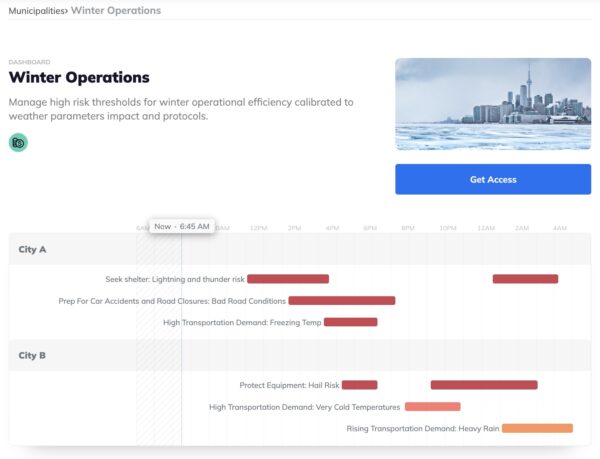TL;DR:
- Cities face a crucial decision in winter: treat roads with salt or scrape them with plows.
- Advanced weather intelligence can help cities make cost-effective decisions.
- Accurate predictions can lead to significant savings in winter operations.
- Tomorrow.io offers a platform for hyperlocal forecasts to optimize resource deployment.
- Beyond winter, advanced weather intelligence can benefit cities year-round in managing various weather-related challenges.
As winter approaches, cities across the country are preparing for another season of snow and ice management.
For public works departments, this means making crucial decisions that impact both city budgets and public safety.
One of the most significant decisions? Whether to treat roads with salt and chemicals or to scrape them clean with plows.
This seemingly simple choice can result in substantial savings over a winter season.
Let’s explore why this decision is so important and how advanced weather intelligence can help cities make the right call every time.
The Treat vs. Scrape Dilemma
Most cities deploy their plows as soon as there’s at least 2 inches of snow on the ground. This standard metric is used from Cleveland to Boston to Baltimore.
But what if you could predict with high accuracy that the snowfall would only reach 1.5 inches?
In this scenario, pre-treating the roads with salt or other de-icing chemicals could prevent snow accumulation altogether, eliminating the need for plowing. The cost difference can be significant: treating roads with brine might cost about $85 to $250 per mile, while a full plowing operation could cost about $150 to $500 per mile.
The Challenge of Accurate Prediction
The problem lies in the difficulty of making accurate, hyperlocal weather predictions. Traditional forecasts often lack the precision needed to make these fine-tuned decisions.
This is where advanced weather intelligence comes into play.
Leveraging Cutting-Edge Technology
At Tomorrow.io, we’ve developed a decision-support platform backed by state-of-the-art weather intelligence. Our system provides hyperlocal forecasts that go beyond just predicting snowfall amounts. We offer precise information on precipitation type and intensity, allowing cities to deploy their resources more effectively.

This level of detail enables public works departments to make informed decisions about when to treat roads and when to scrape them. By optimizing these choices, cities can significantly reduce their winter operations costs while maintaining or even improving road safety.
Real-World Impact
The benefits of these optimized decisions extend beyond just cost savings. By more efficiently managing resources, cities can:
- Reduce unnecessary overtime for workers
- Decrease their carbon footprint by optimizing vehicle deployments
- Improve communication and coordination across city departments
- Enhance public safety by ensuring roads are cleared more effectively
Many of our clients have seen up to a 35% improvement in resource deployment efficiency.
Over the course of a winter, this can translate into substantial savings.
Beyond Winter: Year-Round Benefits
While the treat vs. scrape decision is specific to winter operations, the benefits of advanced weather intelligence extend throughout the year. The same platform can help cities manage other weather-related challenges, from flood mitigation to heat wave response.
As climate change leads to more unpredictable and severe weather patterns, the ability to make smart, data-driven decisions about resource deployment becomes increasingly crucial. By leveraging advanced weather intelligence, cities can not only save money but also provide better service to their citizens, enhance public safety, and contribute to sustainability goals.
The next time snow is in the forecast, remember: the decision to treat or scrape is about more than just clearing roads.
It’s about smart resource management, fiscal responsibility, and building more resilient cities.
With the right tools and intelligence, public works departments can turn winter weather challenges into opportunities for optimization and improvement.

















